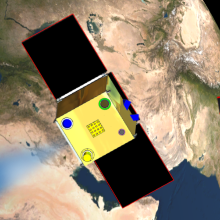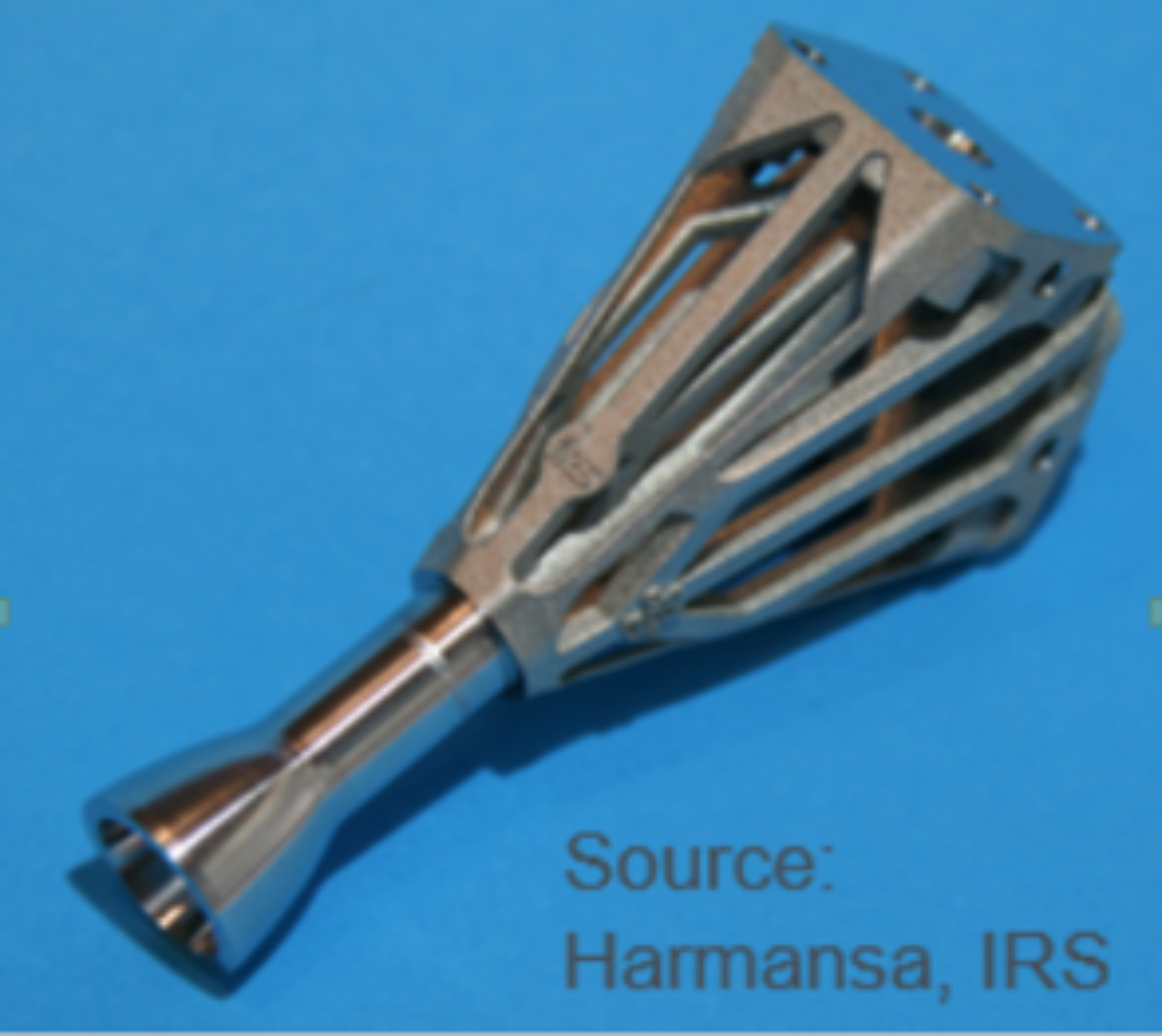The Research and Observatio in Medium Earth Orbit (ROMEO) is a space mission designed by the Institute of Space Systems (IRS) at the University of Stuttgart. The proposed mission scenario is a launch of a 60 kg satellite into a sun-synchronous Low Earth Orbit with an altitude of 600 km, while the apogee will be raised above 2000 km employing a water-propulsion system. This system is a new development and separates water into its chemical components by electrolysis to ignite the gases in the thruster.
Furthermore, the ROMEO platform intends to show that MEO can be an operational field for small satellite missions using commercial components. In contrast to the relatively protected lower Earth orbits, the radiation environment in the orbits passing the Van Allen radiation belt are particularly problematic for electronic components. A radiation tolrerant avionic system is currenlty in development for this mission. An appropriate resilience of the satellite can be ensured by using smart radiation mitigation technologies. Additionally an adaptive communication system is developed to ensure a reliant reachability over all the different orbit stages.
ROMEO supports the study of climate change by carrying a telescope for observing the reflected Earth Albedo on the Moon. A spaceborne instrument can increase the accuracy of the albedo data by one magnitude. The apogee of the orbit is in the inner Van-Allen radiation belt, which is important for space-weather research. On the satellite it is planned to host radiation and magnetic field monitoring systems to research the radiation environment.
Satellite
The main mission driver is to bring the satellite as far into the inner radiation belt as possible in order to demonstrate the spacecrafts’ capability of withstanding the harsh radiation environment. Therefore, the satellite will carry a propulsion system to increase its apogee above 2,000 km, while lowering the perigee. This is necessary to comply with the European Code of Conduct of Space Debris Mitigation even if the propulsion system fails at any point of the mission.
The ROMEO mission of the Institute of Space Systems at the University of Stuttgart is developed to qualify a cost-efficient satellite bus to test new technology in LEO and the lower MEO. ROMEO's scientific payloads will be utilized to study parameters related to Earth's climate change and space-weather phenomena
Orbits and mission phases
The nominal mission duration is 1 year. The mission is divided in three phases to achieve the most success rate for the mission while operating in the radiation belt. In Phase 1, the ROMEO satellite will be launched to a highly inclined Sun Synchronous Orbit (SSO) at an altitude of 600km, because SSOs are the most frequent rideshare opportunities for small satellites. In this phase climate research is conducted with the Earthshine Telescope. In Phase 2, the S/C will use the water propulsion system to increase its apogee above 2,000 km, which will take around 140 days. Phase 3 is in the final orbit of 2500x330 km to conduct research about the inner radiation belt. By lowering the perigee to 330 km a fail-safe comply to the European Code of Conduct for Space Debris Mitigation for reentry within 25 years is ensured.
New technology
Green Propulsion
Due to the incessant quest for green propellants, a new propulsion system for small satellites has been developed, depending solely on water as propellant. Whereas usually highly toxic and corrosive propellants like hydrazine and its derivatives have been used to propel a spacecraft, here water, as an inert substance, is being used. Once the spacecraft is in orbit, low pressure water is decomposed by applying electrical energy via electrolysis to generate highly pressurized hydrogen and oxygen. The gases are stored in separate pressure vessels until recombined in a chemical bi-propellant thruster engine to accelerate the spacecraft.
Highly adaptive X-Band Data Downlink System
The need for high throughput transmissions on small satellite platforms has increased dramatically in the recent years. However, the limited resources on small satellite platforms in terms of mass, volume and power make it difficult to increase factors such as RF output power, antenna size, bandwidth and carrier frequency. An innovative possibility is the use of adaptive approaches for the data transmission, since typically a constant transmission configuration is used. In order to increase the overall data budget of the satellite mission, a new adaptive amateur radio X-band data downlink transmitter is being developed at the IRS which adapts its configuration to the current transmission state.
Radiation tolerant avionics
To enable a cost-efficient access to the Medium Earth Orbit (> 2000 km), radiation tolerant avionics based on smart COTS-Components are developed at the Institute of Space Systems, Stuttgart, Germany in cooperation with the German Aerospace Center DLR. The COTS-Components will be chosen based on previous flight heritage in Cubesat missions and radiation test databases. Redundant systems will be designed with radiation tolerant over-current protection circuitry. Failure modes will be carefully studied and further radiation tests will be conducted. For ICs, insulating substrates will be used, and components rad-tolerant by design will be chosen wherever possible. To reduce the total dose effects, critical components will be shielded. Furthermore, the mission is designed so that the spacecraft will reach harsher environments gradually, in order for the system to be able to adapt and to minimize the risk of immediate loss of mission.
The Albedo mission
What is Earthshine?
- Sunlight striking the Earth and reflecting into space hits the Moon and is reflected towards Earth. On the ‘Dark Side’ of the Moon it is observable and is called ‘Earthshine’. Its intensity tells us about the reflectivity of Earth - ‘albedo‘ - which is a factor determining the climate system’s energy balance.
- Earthshine intensity will follow changes in e.g. cloudiness under climate change, and ice cover, desertification, etc.
- Our understanding of the climate system, and its current changes, depends on knowing the albedo as well as the outgoing long-wave radiation from Earth. LW is easier to measure accurately than short-wave light. Model-based understanding of the climate change is based on relatively good observations of albedo from LEO platforms, but it is not an absolutely well known quantity and hence climate models are not as constrained by observations as they could be with more accurate albedo data as input.
- Observing the albedo by measuring the ratio between the strong illumination of the lunar bright side and the weakly illuminated dark side allows for important gains in measurement accuracy - common-mode rejection, for instance.
Why space based?
Ground-based systems have done Earthshine observation for about two decades now, but the disturbing presence of the atmosphere limits the accuracy to something at the level of accuracy from LEO absolute measurements. The Earthshine technique should be applied from space. Absolute accuracy on photometry in the few-tenths % range are possible, vs. current several %.
The Space Weather Mission
What is space weather?
In analogy to terrestrial weather, space weather describes the changes in the interplanetary and interstellar medium caused by the solar wind, solar flares or cosmic radiation. These radiations interact with the Earth's magnetic field and create the radiation belts (Van Allen belts), which influence the magnetosphere, ionosphere and atmosphere. Increased radiation activity can be seen, for example, in the form of auroras, in which the atmosphere is ionized by the radiation. A problematic effect of space weather is the impact on ground- and satellite-based electronic components, which can lead to failure or even destruction. Knowledge of space weather enables safety measures to be taken to protect critical infrastructure in the event of negative space weather conditions.
How does ROMEO support the measurement of space weather?
Due to its elliptical orbit, the ROMEO satellite orbits both the ionosphere and the inner radiation belt and can detect changes in space weather in these areas. The following three instruments are integrated on the satellite for this purpose:
- ESA space weather instrument MiniRMU (Radiation Measurement Unit)
ROMEO is carrying ESA's space weather observation system MiniRMU, which measures particle radiation consisting of protons, electrons and heavy ions on the satellite and will contribute to current models of space weather. The instrument can detect minute fluctuations in the solar particle flux to predict upcoming coronal mass ejections. These measurements will support ESA's Space Situational Awareness Program. - Langmuir probe of the Royal Institute of Technology, Stockholm
The Royal Institute of Technology in Stockholm operates a Langmuir instrument on the ROMEO satellite measuring the thermal plasma environment in the satellite area as well as its interaction with the fuel of satellite's novel water propulsion system. For this purpose, two deployable Langmuir probes are attached to the satellite's fold-out solar panels, which analyse electron density, electron temperature and plasma potential. - Particle detector RUBIK at Justus Liebig University, Giessen
The third instrument for determining space weather is a sensor system for measuring cosmic particles in the gigaelectronvolt range. The origin of these particles is an open question in science. Possible origins could be supernovae or even the Big Bang itself. The particle detector will determine the trajectory of the high-energy particles. A cube consisting of 125 sensors is used for this purpose. The trajectory of the particle is determined from the excitation of neighbouring sensors on the cube.
Contact

Thorben Löffler
M. Sc.Systems Engineer for Radiation Mitigation in Small Satellite Missions











